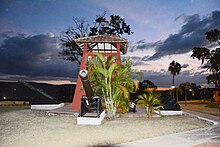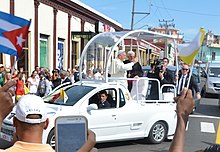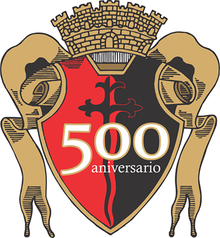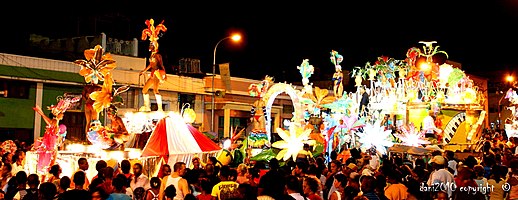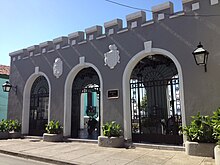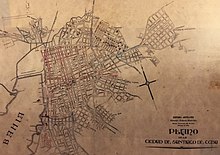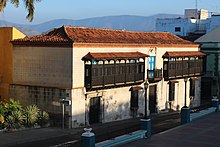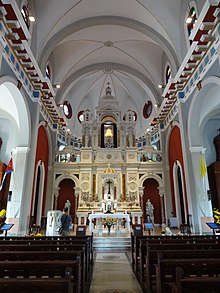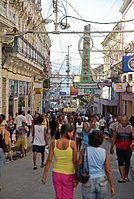Santiago de Cuba
| Santiago de Cuba | |
|---|---|
|
Coordinates: 20 ° 2 ′ N , 75 ° 49 ′ W
Santiago de Cuba on the map of Cuba
|
|
| Basic data | |
| Country | Cuba |
| province | Santiago de Cuba |
| City foundation | 1515 |
| Residents | 510,665 (2015) |
| City insignia | |
| Detailed data | |
| surface | 1,031.74 km² |
| Population density | 495 inhabitants / km 2 |
| height | 82 m |
| Waters | Caribbean Sea |
| Post Code | 90100, 90200, 90300, 90400, 90500, 90600, 90700, 90800, 90900, 91000, 91100, 91200, 91300, 91400 |
| prefix | (+53) 22 |
| Time zone | UTC -5 |
| City Presidency | Raúl Fornés Valenciano ( PCC ) |
| City patron | St. James (Santiago el Mayor) |
| Website | |
| Cathedral and Parque Céspedes | |
Santiago de Cuba is the second largest city in Cuba and the capital of the province of Santiago de Cuba . The city has 510,665 inhabitants (2015 census). Santiago de Cuba, which celebrated its 500th anniversary in 2015, is one of the oldest cities in Cuba. It is located in the southeast of Cuba, around 870 kilometers southeast of the capital Havana .
geography
Location and natural environment
Santiago de Cuba is located in the southeast of Cuba with the coordinates N 20 ° 1'00.948 "W 75 ° 49'48.553", about 870 km from the capital Havana . The center of the city is about 29 m above sea level. Santiago de Cuba is the second largest city in Cuba after Havana. Santiago Bay is on the Caribbean Sea and the port is the second largest seaport in Cuba. The city has grown around the bay of Santiago de Cuba and is surrounded by the mountains of the Sierra Maestra .
climate
In Santiago de Cuba, as in most other areas of Cuba, there is a tropical climate . The effective climate classification of Köppen According prevails in Santiago de Cuba tropical savannah climate .
|
Long-term mean temperature and precipitation (1961–1990)
Source: World Meteorological Organization
|
|||||||||||||||||||||||||||||||||||||||||||||||||||||||||||||||||||||||||||
City structure
Santiago is the capital of the province of the same name. The city is divided into 6 districts, which in turn are divided into various districts ( Consejos populares ):
| Districto | Consejos populares |
Population (2015 census) |
|---|---|---|
| José Martí | José Martí Norte, Agüero - Mar Verde, José Martí Sur, Los Olmos, Mariana Grajales, Manuel Isla Pérez | 130,073 |
| 26 de Julio | Guillermón Moncada, Los Maceos, José María Heredia | 51,942 |
| Antonio Maceo | Altamira, Vista Hermosa, Veguita de Galo, Chicharrones, Flores, Ciudamar | 113.286 |
| Abel Santamaría | Sueño, Vista Alegre, 30 de Noviembre, Santa Bárbara, Abel Santamaría, Haydé Santamaría | 98,881 |
| René Ramos Latourt | El Cobre, El Cristo, Boniato | 65,724 |
| Frank País García | El Caney, Siboney, El Ramón, El Escandel, Sigua | 50,759 |
history
Foundation of the city
Santiago was founded on July 25, 1515 by Diego Velázquez de Cuéllar as one of seven villas , the first towns on the island. In a very short time the city developed into a lively trading center. In the center of the city, Velázquez had a residence built between 1516 and 1530 ( Casa de Velázquez ).
On his advice, the Spanish Crown conferred the title of capital on Santiago de Cuba in 1522, which it held until 1607. At the same time, Santiago de Cuba was the main base of the Spanish Armada in the Caribbean .
Spanish colonial rule and French immigration
The first Spaniards to reach what is now the Mexican coast left Santiago de Cuba on February 8, 1517 and were under the command of Francisco Hernández de Córdoba . Diego Velázquez de Cuéllar had given Hernández de Córdoba the task of discovering new lands and catching slaves . Velázquez de Cúellar equipped another expedition in January 1518. He appointed his nephew Juan de Grijalva to be in command . After Grijalva's return, Velázquez gave the order to the Alkalden (mayor) of Santiago de Cuba, Hernán Cortés , for a third expedition. The means that Cortés invested in the venture, as well as its zeal, worried Velázquez very much afterwards, because he feared that Cortés would not comply with the agreement on profit-sharing. He tried to remove him from his post as captain general, but Cortés quickly boarded the ships intended for the voyage with 400 to 600 men and set sail from Santiago.
Around 1530, copper deposits were discovered west of Santiago (in today's village of El Cobre ). However, due to the lack of metallurgists, they could not be exploited. The Flame Gaspar Lomans began mining there in 1540, supported by Hans Tetzel from Nuremberg since 1542. He traveled back to Spain and Germany to bring more German engineers to Cuba. Equipped with a contract of the Spanish Crown and capital of the Nuremberg Welser , the copper deposits were mined from 1547 until his death in 1576 by native Indians and slaves from the Congo, Cabo Verde and Angola.
In 1554 Santiago was attacked by the pirate Jacques de Sores and his men, and a few weeks later by François Le Clerc and his men. In 1607, Santiago de Cuba was replaced by Havana as the capital. To protect the city from the seaside, the Castillo de San Pedro de la Roca was built from 1637 10 km southwest of the city . This fortress is best known under the name Castillo del Morro and recognized by UNESCO as a World Heritage Site. It was also the port of arrival for the slave ships from West Africa . Even today, most of the population is of African descent there.
In 1686, about 25 km west of Santiago, today's pilgrimage church El Cobre was built, which is considered the national shrine of the Catholics in Cuba .
The wave of French settlers and their slaves from Haiti as a result of the Haitian Revolution from 1791 had a formative influence on the city's social, economic and cultural characteristics originated. The coffee plantation Cafetal Isabélica , located east of Santiago on the world's third largest monolith, Gran Piedra , which has also been a UNESCO World Heritage Site since 2000, was founded by French settlers.
In 1862 the Bacardí & Ca. distillery was founded in Santiago de Cuba . Founded by “Don” Facundo Bacardí Massó (1814–1887) from Sitges (Spain) , the internationally best-known and most successful Cuban business enterprise.
Wars of Independence and Spanish-American War
In 1845 Antonio Maceo was born in Santiago , one of the military leaders of the wars of independence that began in 1868 ( Ten Years War , Guerra Chiquita and Cuban War of Independence ). The east of the island surrounding Santiago was the center of the armed Cuban independence movement.
German consulates (for Bremen, Hamburg and Prussia) had existed in Santiago de Cuba since at least 1856. Carl Wilhelm Schumann was consul of the North German Confederation from 1868 . Hermann Michaelsen , after whom the promenade of Santiago is named, took over the post of patron of the arts and merchant . He practiced it for republican Germany until after 1918 . He was also a founding member of the Santiago Chamber of Commerce, created in 1887, and the first water sports club in Santiago, Club Nautico, in 1889.
In (and near) Santiago de Cuba, the decisive and final skirmishes took place in the summer of 1898 that led to the end of Spanish colonial rule over Cuba in the Spanish-American War : The battle on the hill of San Juan outside the former eastern city limits (today in the district Vista Alegre ) and a few days later the naval battle of Santiago de Cuba .
Batista's dictatorship, beginning and victory of the revolution
At the time of the dictatorship of Fulgencio Batista , the armed struggle by a group around the young lawyer Fidel Castro , who had spent his school days in Santiago, began in Santiago with the storming of the Moncada barracks on July 26, 1953 . While the neighboring Sierra Maestra mountain range became the core area for guerrilla warfare against the state armed forces from 1956, Santiago de Cuba was also the center of the civil resistance led by Frank País . On January 1, 1959, Fidel Castro announced the victory of the Cuban Revolution in Santiago de Cuba , after the military surrendered the city to the rebel army without a fight after Batista's flight from the country .
Santiago de Cuba after the victory of the revolution
On January 1, 1984, President Fidel Castro awarded the city of Santiago the honorary title of City of Heroes of the Republic of Cuba for the special merits of its citizens for the revolution as the only city in Cuba . The city's official motto, which is part of the city's coat of arms, is: "Yesterday rebellious, today hospitable, always heroic". The historical city coat of arms from the Spanish colonial period bore the motto: "Very venerable and very loyal".
On October 25, 2012, Hurricane Sandy wreaked havoc in the entire city and surrounding area of Santiago; Since 1580 the earth has shaken at least fifteen times in Santiago (the last great earthquake on February 3, 1932 had a magnitude of 6.2 degrees on the Richter scale ), as the Caribbean plate runs off the coast of Santiago .
So far, on March 26, 2012, Pope Benedict XVI visited and on September 22, 2015 Pope Francis took over the city. In 2015, Santiago de Cuba celebrated its 500th anniversary. On this occasion, many houses in the city center were renovated by the government.
politics
The current mayor of Santiago de Cuba is Raúl Fornés Valenciano. His deputy is Yanedis Echavarría Batista (both PCC). The city is administered by the Municipal Assembly of People's Power ( Asamblea Municipal del Poder Popular ), chaired by Fornés Valenciano. The first secretary of the Communist Party (PCC) of the Province of Santiago (Primer Secretario del Partido en la Provincia), Lázaro Fernando Expósito Canto , also had a great influence on the fortunes of the city .
Town twinning
-
 Cartagena de Indias , Colombia
Cartagena de Indias , Colombia
-
 Esmeraldas , Ecuador
Esmeraldas , Ecuador
-
 Lisbon , Portugal
Lisbon , Portugal
-
 Maracaibo , Venezuela
Maracaibo , Venezuela
-
 Montego Bay , Jamaica
Montego Bay , Jamaica
-
 Oakland ( California ), USA
Oakland ( California ), USA
-
 Rosario , Argentina
Rosario , Argentina
-
 Sabaneta , Venezuela
Sabaneta , Venezuela
-
 Saint Petersburg , Russia
Saint Petersburg , Russia
-
 Santiago ( Nuevo León ), Mexico
Santiago ( Nuevo León ), Mexico
-
 Santiago de Compostela , Spain
Santiago de Compostela , Spain
-
 Santiago de los Caballeros , Dominican Republic
Santiago de los Caballeros , Dominican Republic
Culture and sights
Santiago de Cuba can be described as the cultural center of Cuba's east, which has a wide range of culture and attractions, such as museums, palaces, colonial-style public spaces, avenues, churches, cinemas, theaters and the annual carnival in July. Today there are museums in many colonial buildings. The Cuban government pays special attention to good access to cultural events, which is why the entrance fees to museums and festivals are usually very low.
Squares and neighborhoods
Parque Céspedes
The central square in the middle of the city can be traced back to the 16th century. In the course of history it had various names from Plaza de Armas to Plaza Mayor to Plaza de Isabel II . It is now named after the first Cuban President Carlos Manuel de Céspedes ; a memorial stone in the middle of the square commemorates his call from Yara , who is considered the beginning of Cuba's independence movement and heralded the end of slavery.
On its south side is the cathedral of Santiago de Cuba , completed in 1818 , whose three stone predecessors can be traced back to 1555.
Opposite the cathedral is the town hall of Santiago, which can be traced back to its beginnings in 1516. Originally, a hospital was attached to the building next to the town hall in the middle and a prison on the other. In 1776 the prison and hospital were closed . Until 1852 the building was almost completely destroyed by various earthquakes and from 1854 it was completely rebuilt. It got its current appearance after the renovation from 1948 to 1954 in the colonial style. On December 31, 1901, the official flag of Cuba was hoisted there for the first time by the then mayor Emilio Bacardí Moreau (before the official introduction on May 20, 1902 in Havana) and on January 1, 1959 from the balcony of the town hall by Fidel Castro, the victory of the Cuban Revolution proclaimed.
On the west side is the Casa de Velázquez , built between 1516 and 1530 , which is considered the oldest house in Latin America and houses a museum.
Opposite the Casa de Velázquez is the four-story Hotel Casa Grande , one of the best hotels in Santiago de Cuba. In 1909, the Cuban Railroad Company bought the territory on the east side of the square to build a hotel. The architect Carlos Segrera took over the planning. The construction company Amigos y Hermanos erected the building in record time; After six months, the building was completed on January 1, 1914 and was inaugurated ten days later. In December 1916, the roof garden designed by Carlos Segrera and realized by Gerardo Vegas was opened, from which a wonderful view over the city is possible. The hotel was completely renovated from 1993 to 1995.
Plaza de Marte
About 800 m west of Parque Céspedes is the Plaza de Marte , which forms the eastern entrance to the alleys of the old town. Established at the end of the 18th century as a parade ground for the Spanish army, it bears the name of the Roman god of war Mars . Although the square was officially renamed Plaza de la Libertad on June 12, 1899 , it is still known by its old name.
The square is a popular meeting place with monuments to José Martí, the revolutionary heroes Alberto Fernández Montes de Oca and Camilo Cienfuegos , as well as Perucho Figueredo (Pedro Felipe Figueredo y Cisneros), the author of the Cuban national anthem, General Francisco Sánchez Hechavarría , first elected governor Oriente Province and Brigadier General Joaquin Castillo Duany , Cuba's first polar explorer. In the center of the square is a victory column with a Jacobin cap on its top and four cannons at its feet.
The foundation stone was laid by the first president of Cuba after independence, Tomás Estrada Palma , on May 2, 1902, and only 18 days later it was inaugurated by Francisco Sánchez Hechavarría.
El Tivolí district
To the southwest of Parque Céspedes is the El Tivolí district , which was founded by French settlers from Haiti in the mid-18th century. The name is derived from a concert cafe for 300 people that used to be in this area. The most striking part of the district is the Calle Padre Pico , a stairway with 52 steps in 13 blocks, which was built in 1899 under the auspices of Mayor Emilio Bacardi.
Above the neighborhood is the Balcón de Velázquez . This terrace, built in the 16th century, was used to monitor the port and maritime traffic, as pirates and corsairs repeatedly attacked the city during this time. Its construction was ordered in 1539 by Hernando de Soto , who had been installed as the new governor of Cuba since June 7, 1538, but the work was not completed until 1550. Today you can enjoy a beautiful view over the harbor for a small fee.
Plaza de Dolores
Between the Parque Céspedes and the Plaza de Marte is the Plaza de Dolores , an approximately 910 m² square, which was named after the former church Iglesia de Dolores located there. Fidel and Raul Castro went to school in the adjacent Colegio de Dolores .
In the middle of the square is the monument to Francisco Vicente Aguilera , one of the wealthiest plantation owners in Cuba at the time, who founded the Bayamo Revolutionary Committee in 1867, which had the aim of bringing Cuba into independence from Spain and its activities ultimately in the ten-year-olds War ended.
The origins of the square go back to the 17th century when a hermitage of Saint Anne was located there. On the ruins of the hermitage, the church Iglesia de Nuestra Señora de los Dolores was built in 1722 . Until 1776 the square formed the eastern border of the city and there was a market for agricultural products there. The church burned down in 1974, was rebuilt as a concert hall from 1986 to 1989 and renamed Sala de Concierto Dolores . The annual International Choir Festival takes place here because of the excellent acoustics. The most valuable piece in the concert hall is a Rieger Kloss organ , of which the company's Czech branch only produced 400 pieces. There are also regular concerts there (including with the Santiago de Cuba-based symphony orchestra Orquesta Sinfónica de Oriente (OSO) ).
In 1967 the square was redesigned with plantings and park benches and it is a popular meeting place with many cafes and restaurants.
Vista Alegre district
The Vista Alegre district , which is about 5 km east of the city center, can be described as the noble district of Santiago de Cuba. After the end of the Cuban Wars of Liberation in 1898 and industrialization, the need for residential buildings for the upper class also arose in Santiago. On June 12, 1907, the entrepreneur and chairman of the Santiago Urbanization and Extension Company y la Caney , José Tomás Nicolau, bought the land of Finca Arroyo Hondo and began the division into plots based on the model of a planned town . Shortly thereafter, the developing district was connected to the city center by a tram line that was inaugurated on February 8, 1908 by the Electricity and Traction Company . From 1907 to 1909, the first 26 wooden villas were built, the number of masonry villas grew to 189 by 1930. A small park with a monument to José-Maria de Heredia was created in the center of the district.
The Pioneer Palace is located in the largest and most famous building . The building was built as Palacio de Bosch in 1916 by Carlos Segrera (1880–1922) for José Bosch Vincens, the co-owner of Marimón, Bosch y Compañía S en C , a company for sugar mills and financial services in Santiago. His son José M. (Pepin) Bosch, who married Enriqueta Schueg Bacardi, was Cuba's finance minister and president of the Bacardi Cooperation from 1951 to 1976 . The architect Carlos Segrera, born and died in Santiago de Cuba, also designed many of the residential buildings and a theater in Vista Alegre.
Furthermore, the Museo de la Imagen , which opened in 1992, is located in the district , in which the history of photography , cinema , radio and television is vividly presented. This museum, unique in Latin America, houses, among other things, a large collection of Kodak cameras from 1888, a television camera that was used at the 1936 Olympic Games in Berlin , the first television camera including an OB van in Cuba, and a silent film camera from that year 1897.
In the Casa de las Religiones Populares , which is also located in Vista Alegre, you can learn everything about the Afro-Cuban Santería cult and other natural religions brought into the country by the African slaves. Here you can experience orisha and voodoo ceremonies or take part in spiritualistic sessions. The nearby Centro Cultural African Fernando Ortiz is dedicated to researching African culture in Cuba and houses a small collection of art from Africa.
Plaza de la Revolución
Following the example of Havana, there has also been a central revolution square in Santiago de Cuba since October 14, 1991, which is used for major events. The Plaza de la Revolución Mayor General Antonio Maceo Grajale is at the northern entrance to the city. There is space for 150,000 people on the 53,000 square meter trapezoidal site. In the middle stands the 16-meter-high statue of Antonio Maceo, designed by the sculptor Alberto Santiago Lescay , who invites you to join the fight. It is composed of 430 bronze elements and weighs around 90 tons. Iron bars representing 23 machetes are placed around the monument. Under the monument there are exhibition rooms with representations in the form of holograms of the Cuban Wars of Independence. An eternal fire burns over the square in memory of the martyrs.
Museums
Museo de Ambiente Histórico Cubano (Casa de Velázquez)
The Museo de Ambiente Histórico Cubano is located in the oldest house in Latin America built by the Spanish, the Casa de Velázquez in the center of the city. After construction began in 1516 under Don Diego Velázquez de Cuéllar, the ground floor was completed in 1519 and the upper floor was expanded until 1530 under Governor Gonzalo Guzmán. It was built in the so-called Mudejar style, which contains a mixture of Moorish and Gothic elements. The barred balcony and the carved wooden ceilings are particularly striking.
The house was restored in the 1940s under the direction of the Cuban archaeologist Francisco Prat, and under his guidance it was expanded as a museum from 1965 to 1970. The museum has ceramics and crockery as well as many European tapestries and furniture from the colonial era. It is one of the most beautiful museums in Santiago de Cuba and gives an insight into the way of life of the upper class of that time. There is also a stone, historic gold melting furnace in the house.
Museo Bacardí
The neoclassical palace is one of the most important museums in Santiago and houses the oldest collection in Cuba (founded in 1899). Construction began on October 28, 1922 and six years later, on May 20, 1928, the Museo y Biblioteca Pública de Santiago de Cuba was opened. It was named after him on the initiative of Emilio Bacardi's widow, Elvira Cape. The public library, which is also located in the building, was named after her.
During the War of Independence of 1895, the Spanish government managed to bring some loans of paintings of European painting from the Prado Museum to Cuba. The government later sent the works to the United States, but Bacardi managed to acquire some of them for his museum. These included paintings by the German neo-classic Rudolf Rössler , the Italian Guido Reni and the Spaniards Juan Pantoja de la Cruz and Federico de Madrazo y Kuntz . Furthermore, various original devotional objects by José Martí , an Egyptian mummy and the printing machine on which Carlos Manuel de Céspedes printed the newspaper El Cuba Libre can be seen in the 16 exhibition rooms on three floors .
The long tradition of the oldest carnival in Cuba comes to life in this museum on Calle Heredia. The exhibits give a good overview of the spectacle that takes place every year around July 25th in Santiago de Cuba and was even the reason why Fidel Castro put the date of the storm on the Moncada barracks on July 26th. In addition to black and white photographs and newspaper articles, elaborately crafted costumes, giant paper mache heads and pictures of artfully decorated floats show how much the Santiagueros love their carnival. The history of the most famous carnival in Cuba goes back to the 17th century, when the ruling class held a service and a procession on the name day of St. James the Apostle, the namesake of Santiago, on July 25th. On this day, the African slaves celebrated their deities - the orishas - with exuberant music and loud chants. Over time, the exuberant spectacle became a permanent fixture, with conga parades and pageants every year celebrating seven days.
Casa Natal de José María Heredia
Opposite the Carnival Museum is the birthplace of one of Cuba's greatest poets and one of America's first romantics, José María Heredia , who saw the light of day there on December 31, 1803. The three rooms of the museum are mainly dedicated to the work and life of Heredia, although at the age of two and a half he moved with his parents to the Dominican Republic and never returned to Santiago. On the house wall are verses of his most famous poem, the Oda a Niágara .
Museo del Ron
The building in which the Rum Museum opened in 1996 was originally built in 1889 for Kindelán Mozo de la Torre, the military governor of Santiago de Cuba. In 1924 it became the property of Mariano Gómez Villasana, the treasurer of the old Bacardi Company . After the Virgilí Maidique family, who lived in the house until 1968, left the country, it was transferred to the Cuban state. Then in 1972 it became the "House of Friendship Cuba - USSR". The history and production from sugar cane to rum is clearly presented in six rooms.
Casa Natal de Antonio Maceo Grajales
The birth house of Antonio Maceo Grajales, the leader of the wars of independence against the Spanish colonial power, known because of his brown skin color, is located near the center at Los Maceo No. 207 (formerly Providencia No. 16).
The house was built between 1802 and 1803 and on August 7, 1857 Maceo's father, Marcos Maceo, bought it from Juana Bautista, after having lived in it with his family for several years. His son Antonio was born there on June 14, 1845. The museum was inaugurated on December 5, 1974 and since December 6, 1978 the house has been a Cuban national monument.
The museum features some family-owned furniture, pieces of family tableware, and other items for personal use, including a table his mother Mariana Grajales used during her stay in Jamaica from 1878 to 1893. The life of Antonio Maceo during the Wars of Independence, beginning in October 1868 until his death in combat on December 7, 1896, is sketched in a separate room. Personal effects on display in another room include a briefcase for documents, binoculars, and a wallet that Maceo used during the war of 1895.
Other sights
Moncada barracks

The history of the Cuartel Moncada begins in the mid-19th century when Santiago needed a prison and a military barracks. On May 6, 1854, Field Marshal Carlos Vargas-Machuca took over general command of the eastern territories of Cuba. Under his direction, the work of the Cuartel del Nuevo Presidio began in 1859 .
The resulting complex of barracks and prison housed 1001 soldiers and 202 prisoners. The barracks were named Reina Mercedes during the Ten Years' War and housed the Spanish cavalry that fought against the Cuban independence fighters at the time. The Príncipe Alfonso military hospital with 300 beds was built next to these buildings in 1878 . During the Wars of Liberation, the complex acquired great strategic importance and on January 2, 1894, General Guillermo Moncada was imprisoned in the barracks, where he and other comrades had spent six months. After the conquest of Santiago by American troops, the barracks and hospital remained under their management until July 31, 1902.
On April 24, 1909, the complex was named after General Guillermón Moncada and on December 11, 1937 a fire destroyed important parts of the ensemble and a rapid reconstruction in the Art Deco style began. The new facility was inaugurated on September 4, 1938 and then housed 2,000 soldiers.
On July 26, 1953, young fighters led by the young lawyer Fidel Castro stormed the barracks, at the same time as the Carlos Manuel Céspedes barracks in Bayamo , in order to enforce their right to resistance enshrined in the Cuban constitution, as Fulgencio Batista had launched a military coup the year before the power had come. Previously, the group of 135 men and women had come together on the Villa Blanca farm (now the Granjita Siboney Museum ), which is about 13 kilometers south of Santiago. A troop of 21 men led by Abel Santamaría attacked the civil hospital, another of ten men under the command of Raúl Castro occupied the Palace of Justice and Fidel Castro and 95 men attacked the Moncada barracks. The attack failed and 6 of the attackers and 19 soldiers were killed.

On January 8, 1959, during the Cuban Revolution, the barracks finally came into the hands of the revolutionaries. On January 28, 1960, the complex was converted into a school, where around 1,600 students now study. A museum has also been set up to shed light on the history of the attack on the barracks and the consequences. The bullet holes in the facade from the attack in 1953 have been carefully tended and are still clearly visible.
Casa de la Trova
One of the places where Cuban music celebrates is the Casa de la Trova in Calle Heredia in the heart of Santiago. It was there that the first and original Afro-Cuban music house for the archetype of Cuban music, the Son , was built, which the Buena Vista Social Club made world-famous. It is the basis for many Latin American music styles. In the traditional Son, Spanish singing is merged with African rhythms and the Spanish guitar. There, locals and tourists alike can shake their legs according to typical Cuban rhythms.
Cementerio Santa Ifigenia
The Cementerio Santa Ifigenia cemetery , located northwest outside the city center, is one of the most famous cemeteries in Cuba, as many personalities from Cuba's history are buried there. It was inaugurated on April 22, 1868 and declared a national monument in 1937, which was confirmed again in 1979 by Fidel Castro. It houses around 8000 graves. Its name is derived from the holy Iphigenia, an Ethiopian virgin and martyr of the 1st century.
The most impressive tomb in the cemetery is the mausoleum of José Martí. The grave of honor, inaugurated on June 30, 1951, rests the body of the national hero, thinker and leader of the resistance against the Spanish occupation who fell on May 19, 1895. The 24 meter high granite tower is an example of the rationalist tombs that were laid out from the middle of the 20th century. A changing of the guard of the three-man honor guard takes place every 30 minutes to the sounds of Elegía a Martí .
Famous personalities such as Fidel Castro , Carlos Manuel de Céspedes , María Cabrales (widow of Antonio Maceo), Frank País , Emilio Bacardí Moreau, Francesco Antommarchi (Napoleon's last personal physician) and Compay Segundo are buried in the cemetery.
Cayo Granma
The only 2.2 km² large island in the bay in front of Santiago de Cuba previously served as a guard post against attacking pirates. In the 19th and 20th centuries, when the island was still called Cayo Smith , many Santiagueros summer houses were built there. In 1870 it already had 184 inhabitants. The church of San Rafael on the highest point of the island (9 m) was consecrated in 1877. In 1961 it was renamed Cayo Granma in thanks to the people living on the island who supported the Cuban revolution .
Today the island can be reached from the mainland by an hourly ferry. There is a post office, a school and many restaurants, especially popular with tourists.
Castillo del Morro
| Castillo de San Pedro de la Roca | |
|---|---|
|
UNESCO world heritage |
|

|
|
| Part of the fortifications |
|
| Type: | Culture |
| Criteria : | iv, v |
| Surface: | 93.88 ha |
| Reference No .: | 841 |
| History of enrollment | |
| Enrollment: | 1997 (session 21) |
About 10 km southwest of Santiago de Cuba is the Castillo de San Pedro de la Roca (also known colloquially as Castillo del Morro ). Considered the best preserved and most complete example of Spanish-American military architecture, the fortress was declared a World Heritage Site by UNESCO in 1997 .
The fortress was designed in 1637 by Juan Bautista Antonelli (1585–1649). It was designed by the governor of Santiago, Pedro de la Roca y Borja , as a defense system against pirate attacks and was intended to replace an earlier, smaller fortification from the years 1590 to 1610.
Antonelli's design was adapted to the location of the fortress on the steep flanks of a protrusion reaching into the bay - morro , after which the fortress is also named. The fortress was built on several terraces. There were four main levels and three large bastions for the artillery. Supplies were delivered over the sea and stored in a large warehouse carved directly into the rock or taken to the citadel on the top level. It took 42 years to build the citadel. It began in 1683 and ended with several interruptions in 1700. Between 1675 and 1692 the fortress was damaged by several earthquakes. From 1693 to 1695, repairs were carried out under Francisco Pérez. Further work was carried out in 1738–1740 by the engineer Antonio de Arredondo , who enlarged the citadel and completed some of the previously unfinished platforms. Juan Martín Cermeño and Francisco Calderín made final changes to the structure after it was again damaged by earthquakes between 1757 and 1766.
From 1775 the parts of the fortress known as "the rock" ( la Roca ) and "the star" ( la Estrella ) were converted into a prison for political prisoners. The rest of the fortress remained a military base.
The fortress was last used for military purposes in 1898 when the United States' navy attacked Santiago de Cuba during the Spanish-American War.
In the 20th century the fortress fell into disrepair. In the 1960s it was restored under Francisco Prat Puig. It has been accessible as a museum since 1978 and has been an official national monument since 1979.
| Archaeological landscape of the first coffee plantations in southeast Cuba | |
|---|---|
|
UNESCO world heritage |
|

|
|
| Cafetal Isabélica, main building |
|
| Type: | Culture |
| Criteria : | iii, iv |
| Surface: | 81,475 ha |
| Reference No .: | 1008 |
| History of enrollment | |
| Enrollment: | 2000 (session 24) |
Natural Park (Parque) Baconao and the historic La Isabélica coffee plantation
The Baconao Natural Park , which belongs to the municipality of Santiago, was included in the list of biosphere reserves by UNESCO in 1987. It is located around 20 km from the city. It offers numerous sights on 85,000 hectares. On the western edge of the park near the city is the 1234 meter high Gran Piedra mountain, on which a botanical garden and the highest viewing platform in the area can be visited.
On the way to the mountain top is the historic coffee plantation Cafetal Isabélica , which was also included in the UNESCO World Heritage List in 2000 as part of the archaeological landscape of the first coffee plantations in southeastern Cuba . The tradition of growing coffee originally comes from Saint Domingue (today's Haiti) on the island of Hispaniola , where it has been cultivated by French settlers since the 18th century. At the time of the slave revolts from 1790 and the subsequent founding of the state of Haiti, some of these settlers fled with their slaves to nearby Cuba and established the coffee-growing tradition there. From the Caribbean islands, coffee cultivation spread to other countries in South and Central America.
The landowner Víctor Constatan initially had corn, cocoa and coffee grown after his escape from Haiti. He named the plantation after his wife Isabel María. There you can visit the manor house with a drying terrace (Secaderos), the kitchen and workshop building, a mill (Molino) and the remains of the slave accommodation. The upper floor of the main house, which was built between 1820 and 1830, is a wooden structure on the basement made of natural stone. The upper floor was destroyed over time and has been reconstructed using traditional craft techniques. The rooms are furnished with furniture from the plantation era. The basement has survived largely undamaged. The facility has served as a museum since 1961.
Like all coffee plantations, the plantation is located in a special microclimate. Due to the altitude of about 1130 m and the prevailing wind directions, the temperature spectrum is moderate and the moisture for the coffee plants is ensured by condensate from the clouds.
Basílica Santuario Nacional de Nuestra Señora de la Caridad del Cobre
The national shrine of the Catholics of Cuba and also a pilgrimage church was rebuilt in 1926 after a church had existed in the same place since 1686. It rises above the small village of El Cobre around 20 km west of Santiago de Cuba and is accessible via 254 steps. Inside is the figure of the Blessed Virgin of Cobre (span: Virgen de la Caridad del Cobre), which has been venerated since 1612 and is the most important object of pilgrimages in Cuba.
In 1915 the veterans of the War of Liberation Pope Benedict XV. asked to declare the Blessed Virgin of El Cobre the patron saint of Cuba. Pope John Paul II crowned and blessed them on his visit to Cuba in 1998, and on March 27, 2012, Pope Benedict XVI venerated them. the Virgin of El Cobre on the four hundredth anniversary of the anniversary of her discovery a golden rose during his pilgrimage to Cuba. The church houses an impressive collection of votive offerings , including the Nobel Prize medal from Ernest Hemingway .
economy
Santiago de Cuba is one of the economic centers in eastern Cuba. The Hermanos Díaz refinery (oil and gas), the Renté thermoelectric factory, the José Merceró cement factory are among the most important companies and largest employers in Santiago. There are also various sugar factories in the area around Santiago, so that the area around Santiago de Cuba is one of the most important centers of sugar production in Cuba. In addition, the rum factory (formerly Bacardi ) and the beer factory Fábrica de Cerveza Hatuey (since 1919, founded as the Santiago Brewing Company ) should be mentioned. Tourism in and around Santiago is also gaining in importance .
Infrastructure
Air traffic to and from Santiago de Cuba and the surrounding area is served by the airport "Antonio Maceo" (Spanish: Aeropuerto Internacional Antonio Maceo y Grajales ). It is located about 10 km south of the city center. The airport is one of the most important in eastern Cuba, both for domestic and international flights. The airlines offered connect Santiago to Havana, Rome , Montréal , Port-au-Prince , Santo Domingo and Toronto, among others .
The regional bus traffic is served with the so-called Omnibus Metropolitanos (OM) and metrobuses. The metro buses drive to the inner-city destinations with a maximum distance of 20 km, while the Ómnibus Metropolitanos (OM) drive to destinations in the Santiago area with a maximum distance of 40 km. State taxis complement the regional transport offer.
The Cuban railway company Ferrocarriles de Cuba , the ASTRO buses and the Viazul buses, which are mostly used for tourist transport, connect Santiago with Havana and the largest cities in Cuba. The central train station General de División Senén Casas Regueiro and the central bus station are located next to the port of Santiago and were completely rebuilt in 1997.
The state central motorway Autopista Nacional de Cuba A-1 (not completed), which was supposed to connect Havana with Guantánamo , runs north of Santiago de Cuba.
In addition to the state transport options, a number of private initiatives complement the transport offer, of which the motor taxis deserve special mention, which mostly chauffeur passengers through the city on MZ motorcycles from the former GDR for a price of 1 CUC .
The port of Santiago de Cuba Puerto Guillermón Moncada is the second largest in Cuba. It is currently being expanded by Chinese investors. This is also increasingly a point of contact for international cruise ships.
A tram network existed in Santiago de Cuba until 1952, which was installed in 1908. The lines reached from Vista Alegre over the center to El Cobre.
education
Santiago de Cuba has various educational institutions. There are 54 kindergartens with 8,800 places available. There are 161 primary schools, 35 secondary schools and 10 schools called Preuniversitario for obtaining the higher education entrance qualification.
Santiago de Cuba also has two universities. The Universidad de Oriente is the second oldest university in Cuba, is located in the Sueño district and its origins go back to the Priestly College of San Basilio el Magno , founded in 1722 , but it was not officially founded until October 10, 1947. There are around 1300 lecturers for 10,000 students. At the Universidad de Ciencias Médicas de Santiago , which emerged in 1962 from the medical faculty of the Universidad de Oriente , 24 medical specializations can be studied.
Sports
Various facilities are available for sport in Santiago. The largest is the Estadio Guillermón Moncada baseball stadium . Inaugurated on February 24, 1962 with a capacity for 15,000 spectators, it is the home of the Santiago baseball team of Las Avispas Santiagueras .
Health facilities
All Cubans have access to the nationwide free health system, which in Santiago de Cuba also has numerous local family doctors in the individual municipalities as well as central hospitals, polyclinics and special facilities. In 2016 there were 516 medical facilities in Santiago, including 10 hospitals, 17 polyclinics and 472 medical consultation points. A total of 7037 doctors and 681 dentists practice in Santiago. They are supported by 4,134 nurses.
Personalities
literature
- Sandro Parrinello / Flora Morcate Labrada (ed.): El Reparto de Vista Alegre en Santiago de Cuba . Edifir Edizioni Firenze, Florence 2008, ISBN 978-88-7970-402-1 .
- Wolfgang Ziegler: Cuba. Michael Müller Verlag, Erlangen 2011, ISBN 978-3-89953-531-0 , pp. 654-697.
Web links
- Official website of the city and province
- Website of the city of the Universidad de Oriente (Spanish)
- La Ciudad de Santiago de Cuba (Spanish)
- The foundation of the city of Santiago, Diego Velázquez and Hernán Cortés
- Information about the province, region and city, travel planning, excursions, hotels and casas
Individual evidence
- ↑ Declaran a Correa Hijo Ilustre de la ciudad de Santiago. Retrieved February 2, 2018 (Spanish).
- ↑ ONE, 2015 census, page 18
- ^ World Meteorological Organization: World Weather Information Service
- ↑ Geoffrey Parker (Ed.): The Times - Great Illustrated World History. Verlag Orac, Vienna 1995, p. 270.
- ^ Theodor Gustav Werner: The copper smelting works of Hans Tetzel from Nuremberg on Cuba and its financing by European finance capital. In: Quarterly for social and economic history. Volume 48, Issue 3, 1961, pp. 289-328.
- ↑ Michael Zeuske: Black Caribbean. Rotpunktverlag, Zurich 2004, p. 119.
- ^ Marley: Wars of the Americas . P. 57.
- ↑ Illustrated calendar for 1856. JJ Weber's publishing house. Leipzig 1856, p. 27
- ↑ Foreign missions. Accessed January 30, 2018 .
- ^ Raúl Martell: Curiosidades de la presencia alemana en Cuba. ( Memento of November 2, 2013 in the Internet Archive ) In: Cubarte of January 24, 2008, accessed on August 24, 2018 (Spanish)
- ↑ An Earthquake Played Havoc with Santiago de Cuba 82 Years Ago. Retrieved January 30, 2018 .
- ↑ Juran nuevos Delegados del Poder Popular de Santiago de Cuba. Retrieved February 2, 2018 (Spanish).
- ↑ Ayuntamiento de Santiago de Cuba. Retrieved January 30, 2018 (Spanish).
- ↑ https://www.ecured.cu/Hotel_Casa_Granda
- ↑ Joaquin Castillo Duany primer cubano que lego al polo norte. Retrieved April 18, 2018 (Spanish).
- ↑ Plaza de Marte. Retrieved April 18, 2018 (Spanish).
- ↑ district El Tivoli. Retrieved February 4, 2018 (Spanish).
- ^ Balcon de Velázquez. Retrieved February 4, 2018 (Spanish).
- ^ Plaza de Dolores. Retrieved August 23, 2018 (Spanish).
- ^ Sala de Concierto Dolores. Retrieved August 23, 2018 (Spanish).
- ↑ Vista Alegre district. Retrieved September 12, 2018 (Spanish).
- ^ Wolfgang Ziegler: Cuba. Michael Müller Verlag, Erlangen 2011, ISBN 978-3-89953-531-0 , pp. 683f.
- ↑ Plaza de Revolución. Retrieved August 27, 2018 (Spanish).
- ↑ Casa de Diego Velázquez. Retrieved September 21, 2018 .
- ^ Oldest house in Latin America. Retrieved September 21, 2018 .
- ^ Museo Provincial de Santiago de Cuba Emilio Bacardí Moreau. Retrieved January 30, 2018 (Spanish).
- ↑ El Museo del Prado in Santiago de Cuba. Retrieved January 30, 2018 (Spanish).
- ^ Casa Natal José María Heredia. Retrieved February 12, 2018 (Spanish).
- ↑ Museo del Ron. Retrieved September 20, 2018 (Spanish).
- ^ Museo Casa Natal Antonio Maceo Grajales. Retrieved September 15, 2018 (Spanish).
- ^ Granjita Siboney. Retrieved September 20, 2018 (Spanish).
- ^ Moncada district. Retrieved September 20, 2018 (Spanish).
- ↑ Casa de la trova. Retrieved September 20, 2018 .
- ^ Cementerio Santa Ifigenia. Retrieved January 30, 2018 (Spanish).
- ↑ Where the great heroes rest. Accessed January 30, 2018 .
- ↑ Cayo Granma. Retrieved November 3, 2018 (Spanish).
- ^ Castello del Morro. Retrieved September 14, 2018 (Spanish).
- ^ Parque Baconao. Archived from the original on April 30, 2009 ; accessed on January 30, 2018 .
- ↑ Cafetal Isabelica. Retrieved September 14, 2018 (Spanish).
- ^ El Cobre Basilica. Retrieved September 20, 2018 (Spanish).
- ^ GDR two-wheelers in Cuba: MZ shapes Havana and Santiago de Cuba. Accessed January 30, 2018 .
- ↑ Cuba expands port of Santiago de Cuba. Accessed January 30, 2018 .
- ↑ New permits for Cuba cruises 2017. Accessed January 30, 2018 .
- ↑ Historias de tranvías. Retrieved January 30, 2018 (Spanish).
- ^ ONE, 2015 census p.98
- ^ Estadio Guillermón Moncada. Retrieved September 14, 2018 (Spanish).
- ^ ONE, 2015 census p.103







